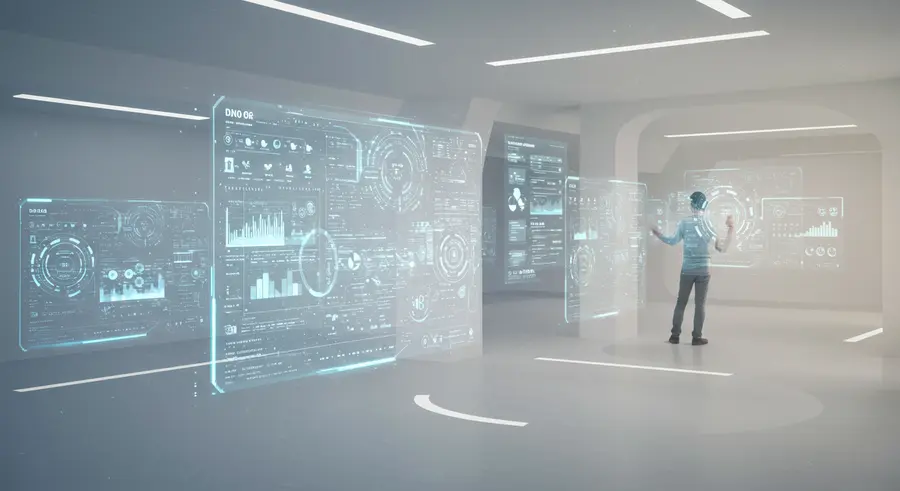Appearance

Welcome, tech pioneers! 👋 Today, we're embarking on a fascinating journey into the realm of Spatial Computing. This isn't just another tech buzzword; it's a revolutionary paradigm that promises to fundamentally change how we interact with digital information and the world around us. Forget flat screens and traditional interfaces – spatial computing is about blending the digital with the physical, creating immersive and intuitive experiences that feel truly natural.
What Exactly is Spatial Computing?
At its core, spatial computing is a human-computer interaction model where digital data and processes are deeply integrated with our physical environment. Instead of interacting with a computer through a screen, you interact within a space. Think of it as bringing digital objects, interfaces, and experiences into your real-world surroundings, allowing you to manipulate them with gestures, voice commands, and movement, much like you would with physical objects.
It's an umbrella term that encompasses technologies like:
- Augmented Reality (AR): Overlaying digital information onto the real world (e.g., Pokémon Go, Snapchat filters).
- Virtual Reality (VR): Creating fully immersive digital environments that replace your view of the real world (e.g., Meta Quest, PlayStation VR).
- Mixed Reality (MR): A hybrid of AR and VR, where digital objects can interact with the physical world and vice-versa, often leveraging depth sensing and environmental understanding (e.g., Microsoft HoloLens, Apple Vision Pro).
The magic happens when these technologies, powered by advanced AI and computer vision, understand the spatial context of your environment. They can map rooms, track your movements, recognize objects, and even predict your intentions, making digital interactions feel incredibly seamless and responsive.
How Does It Work? The Core Components
Spatial computing relies on several key technological pillars:
- Sensors and Data Capture: Devices are equipped with cameras, depth sensors (LiDAR), accelerometers, gyroscopes, and microphones to capture real-time data about the physical environment and the user's movements and voice.
- Environmental Mapping and Understanding: This data is used to build a 3D model of the real world, identify surfaces, objects, and obstacles, and understand the spatial relationships between them. This is often achieved through Simultaneous Localization and Mapping (SLAM) algorithms.
- Computer Vision and AI: Advanced AI algorithms process the captured visual and spatial data to recognize gestures, track eye movements, understand voice commands, and even interpret user intent.
- Rendering and Display: Digital content is rendered in real-time and displayed in a way that blends seamlessly with the physical world, whether through transparent lenses (AR/MR) or fully immersive displays (VR).
- Interaction Modalities: Users interact not just with touch, but with natural movements like hand gestures, head gaze, voice commands, and even haptic feedback.
Why is Spatial Computing a Game Changer?
The implications of spatial computing are vast and truly transformative across numerous industries:
- Enhanced Productivity: Imagine architects designing buildings by walking through holographic models, or surgeons practicing complex procedures on virtual organs overlaid onto mannequins.
- Immersive Education and Training: Students can explore historical sites as if they were there, or learn complex machinery by disassembling and reassembling virtual components.
- Revolutionized Entertainment: Gaming becomes more physical and interactive, and social experiences can transcend geographical boundaries.
- New Retail Experiences: Customers can virtually try on clothes, visualize furniture in their homes, or interact with digital product information directly on store shelves.
- Industrial Applications: Engineers can collaborate on 3D models from different locations, and maintenance workers can get real-time instructions overlaid on machinery.
Examples in Action
While the Apple Vision Pro has brought spatial computing into the mainstream spotlight, the concept has been evolving for years:
- Industrial Maintenance: Technicians use AR headsets to overlay schematics and repair instructions directly onto complex machinery, reducing errors and training time.
- Healthcare: Surgeons use mixed reality to visualize patient data in 3D during operations, enhancing precision and safety.
- Design and Prototyping: Automotive designers can create full-scale virtual car models and iterate on designs collaboratively in a shared spatial environment.
- Navigation: AR navigation apps overlay directions onto your real-world view, making it easier to find your way.
The Road Ahead
Spatial computing is still in its early stages, but its potential is undeniable. As hardware becomes more powerful, compact, and affordable, and as AI and computer vision continue to advance, we can expect to see spatial computing weave itself into the fabric of our daily lives, transforming everything from how we work and learn to how we play and connect.
For more insights into cutting-edge technologies, check out our Emerging Technologies catalogue! Specifically, you can find more about the "Exploring Spatial Computing" entry here.
Get ready to step into the next dimension of digital interaction! 🚀